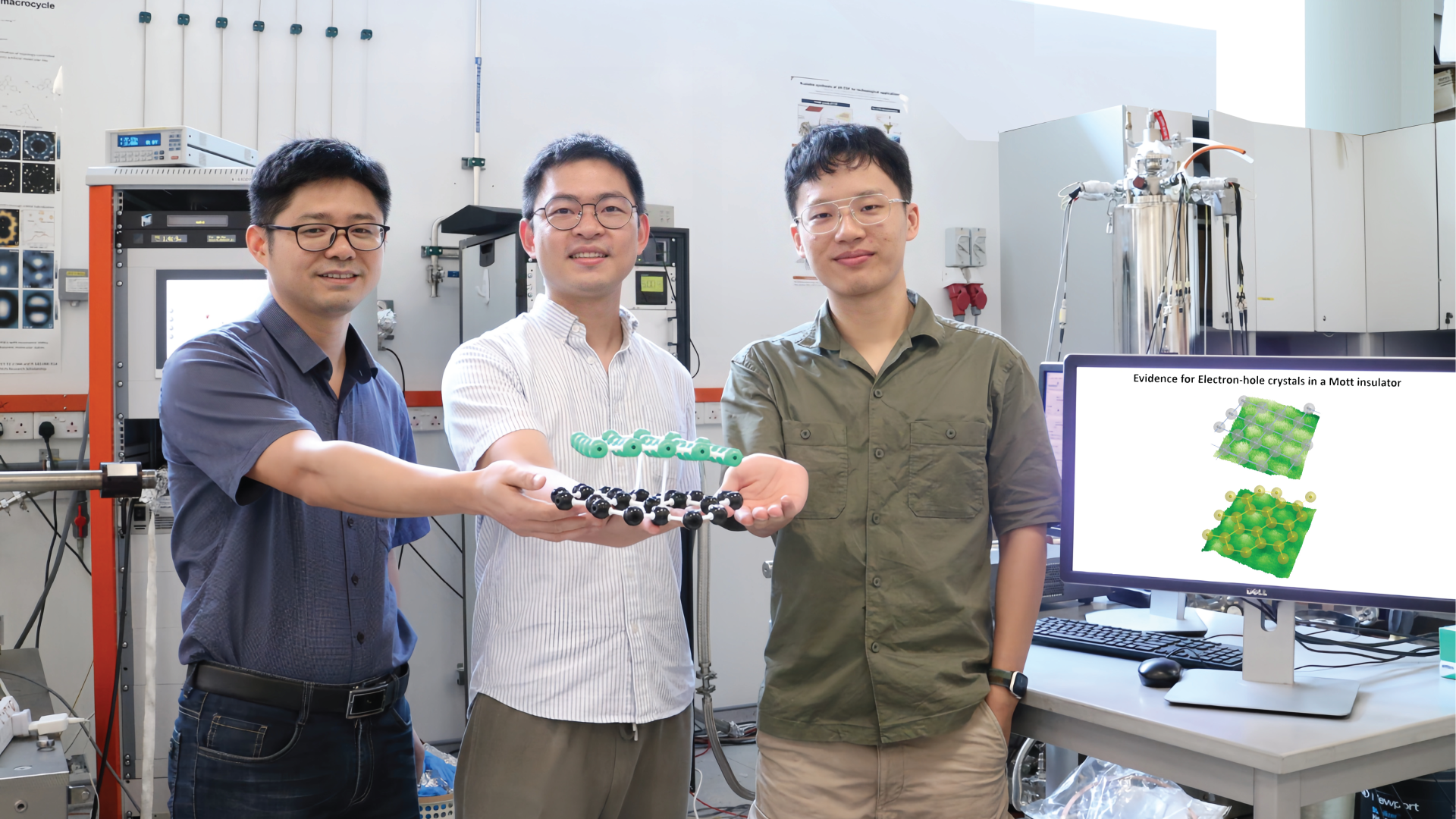In a study published in Nature Materials, a research team from the National University of Singapore (NUS) achieved a significant breakthrough by generating and directly observing electron-hole crystals in an unusual quantum material known as a Mott insulator, specifically Alpha-ruthenium (III) chloride (α-RuCl3).
 From left to right: NUS researchers Assoc Prof. Lu Jiong, Dr. Qiu Zhizhan, and Mr. Han Yixuan were part of the multidisciplinary research team that visualized elusive electron-hole crystals with their novel method that uses an exotic quantum material. Image Credit: National University of Singapore
From left to right: NUS researchers Assoc Prof. Lu Jiong, Dr. Qiu Zhizhan, and Mr. Han Yixuan were part of the multidisciplinary research team that visualized elusive electron-hole crystals with their novel method that uses an exotic quantum material. Image Credit: National University of Singapore
When the number of electrons equals the number of lattice sites in a material, strong electron interactions can lead to the formation of an "electron crystal," where electrons arrange themselves in an orderly pattern. This collective behavior of electrons can be particularly valuable for quantum simulations. When both electrons and their positive counterparts, known as holes, coexist in the same system, they can give rise to even more complex quantum states. One such state is a type of counterflow superfluidity, where electrons and holes move in opposite directions without energy loss or resistance.
However, maintaining the stability of these electron and hole crystals is challenging, as they tend to recombine quickly.
To address this, scientists often separate them into different layers or hosts. Although this technique has demonstrated electron-hole states in multi-layered systems, observing these states in a single natural material remains a contentious issue. This is primarily due to the lack of sufficient experimental evidence and the difficulty in identifying exotic quantum materials that can sustain electron-hole crystals without their mutual cancellation.
A research team from the NUS has recently made significant progress in this area. They successfully created and directly visualized electron-hole crystals in a unique quantum material known as a Mott insulator, specifically Alpha-ruthenium(III) chloride (α-RuCl3). This breakthrough opens up new avenues for exploring quantum excitonic states, potentially leading to advancements in technologies like in-memory and quantum computing.
The groundbreaking observations were enabled by a novel technique combining scanning tunneling microscopy (STM) with graphene. STM, which uses quantum tunneling to produce atomic-scale images, is traditionally limited to studying conductive materials.
To overcome this, the researchers used graphene, a single-layer carbon material with high electrical conductivity, as a medium. Graphene not only allows electrons to pass through and reveal the underlying Mott insulator's electronic structure but also provides a tunable electron source for doping α-RuCl3 non-invasively.
The STM imaging revealed two distinct ordered patterns corresponding to the lower and upper Hubbard bands of α-RuCl3, each with unique periodicities and symmetries. By adjusting carrier densities through electrostatic gating, the researchers were able to directly observe transitions between these orderings. This observation strongly suggests that these orderings are due to electron-hole crystals that reorganize spontaneously as the number of electrons and holes per unit cell is varied.
Usually, when a Mott insulator is doped, the strong interactions between electrons cause the excess carriers to arrange themselves into an orderly pattern. So, it is not surprising to see new charge orderings in a doped Mott insulator. However, it was quite unexpected to observe two distinct orderings emerging simultaneously. Our work attributes this surprising discovery to the formation of electron-hole crystals in the presence of coexisting electrons and holes.
Lu Jiong, Associate Professor, Department of Chemistry, National University of Singapore
Direct Visualization of Electron-Hole Crystals
Observing electron-hole crystals directly at the atomic level reveals their shape and structure with remarkable precision, offering insights that were previously only speculative based on mesoscopic studies. These observations demonstrate that electron-hole crystals can exhibit uneven distributions, with an imbalance in the quantity of electrons and holes present.
Moving forward, we want to explore how we can control these crystals using electrical signals in new ways. Finding electron-hole crystals in doped Mott insulators could lead to new ways to make materials that can switch between different states quickly, which has the potential to facilitate the development of powerful computers. It also opens up the possibility of creating new materials that could have applications such as simulating quantum physics.
Lu Jiong, Associate Professor, Department of Chemistry, National University of Singapore
Journal Reference:
Qiu, Z., et. al. (2024) Evidence for electron–hole crystals in a Mott insulator. Nature Materials. doi:10.1038/s41563-024-01910-3